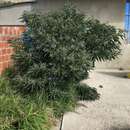Description
provided by Phytokeys (archived)
Shrubs or small trees, 1–4 m tall. Stems densely pubescent with fine, grey, dendritic trichomes, these soon deciduous; leaf scars somewhat raised; new growth sparsely to densely pubescent with fine, grey, dendritic trichomes. Bark of older stems grey, glabrous. Sympodial units plurifoliate. Leaves simple, 6–9 (12) cm long, 1.5–2.5 (5) cm wide, narrowly elliptic, larger and broader in plants growing in shade (see discussion), often shiny above, both surfaces glabrous to densely pubescent with fine dendritic trichomes, these denser along the veins, with most specimens glabrous to sparsely dendritic pubescent; primary veins 12–15 pairs, prominent and parallel; base acute, somewhat winged on to the petiole; margins entire, not revolute; apex acute; petiole 1–1.5 cm long. Inflorescences terminal, later appearing lateral from overtopping of the shoots, 3–7 cm long, pyramidal, branching 8–10 times, with 10–20 flowers, sparsely to densely dendritic pubescent; peduncle 0.5–1.5 cm long, the branching often beginning just distally to the last leaf; pedicels 0.7–1.2 cm long, tapering from a basal diameter of 0.5 mm to an apical diameter of 1 mm, densely pubescent with fine, grey, dendritic trichomes, deflexed or horizontal at anthesis, articulated at the base and inserted in a sleeve ca. 0.5 mm long; pedicel scars closely spaced and clustered near the inflorescence branch tips. Buds globose, later elliptical, strongly exserted from the calyx tube. Flowers all perfect, 4–5-merous. Calyx tube 1–2.5 mm long, conical, the lobes 1–3 mm long, deltate to long-triangular, densely pubescent abaxially with fine dendritic trichomes, pubescent with fine dendritic trichomes in the upper 1/2 adaxially. Corolla 1.5–2.4 cm in diameter, violet or occasionally white, stellate and slightly cupped, lobed 3/4 of the way to the base, the lobes 9–12 mm long, 5–7 mm wide, planar at anthesis, densely pubescent abaxially with fine dendritic trichomes, glabrous or sparsely pubescent along the midvein adaxially, the trichomes denser at the tips of the lobes. Filament tube absent; free portion of the filaments ca. 1 mm long, glabrous; anthers 2.5–3 mm long, ca. 1 mm wide, loosely connivent, poricidal at the tips, the pores becoming slit-like upon drying. Ovary glabrous or with a few dendritic trichomes near the apex, glabrate in fruit; style 6–8 mm long, sparsely to densely pubescent with dendritic trichomes at the base or along the entire length; stigma capitate to clavate, the surface minutely papillose. Fruit a globose berry, 0.7–1 cm in diameter, greenish black when immature and becoming bright red at maturity, with thin pericarp, the calyx lobes to 4 mm long and somewhat accrescent and woody in fruit; fruiting pedicels 1.2–1.5 cm long, ca. 1 mm in diameter at the base, woody, deflexed. Seeds ca. 20 per berry, 2–2.5 mm long, 1.5–2 mm wide, reddish-brown, flattened lenticular, the surfaces minutely pitted. Chromosome number: not known.
- bibliographic citation
- Knapp S (2013) A revision of the Dulcamaroid Clade of Solanum L. (Solanaceae) PhytoKeys 22: 1–432
- author
- Sandra Knapp
Distribution
provided by Phytokeys (archived)
(Figure 68). From central Ecuador to Bolivia, 3000–4000(-4500) m.
- bibliographic citation
- Knapp S (2013) A revision of the Dulcamaroid Clade of Solanum L. (Solanaceae) PhytoKeys 22: 1–432
- author
- Sandra Knapp
Ñuñumaya
(
Quechua
)
provided by wikipedia emerging languages
- license
- cc-by-sa-3.0
- copyright
- Wikipedia authors and editors
Ñuñumaya: Brief Summary
(
Quechua
)
provided by wikipedia emerging languages
Chinchi-chinchi, ñuñumaya, muñuway, takachilla icha puka luri wich'u (Solanum nitidum) nisqaqa Piruwpi wiñaq hampi yuram.
- license
- cc-by-sa-3.0
- copyright
- Wikipedia authors and editors
Solanum nitidum: Brief Summary
(
Vietnamese
)
provided by wikipedia VI
Solanum nitidum là loài thực vật có hoa trong họ Cà. Loài này được Ruiz & Pav. miêu tả khoa học đầu tiên năm 1799.
- license
- cc-by-sa-3.0
- copyright
- Wikipedia tác giả và biên tập viên

